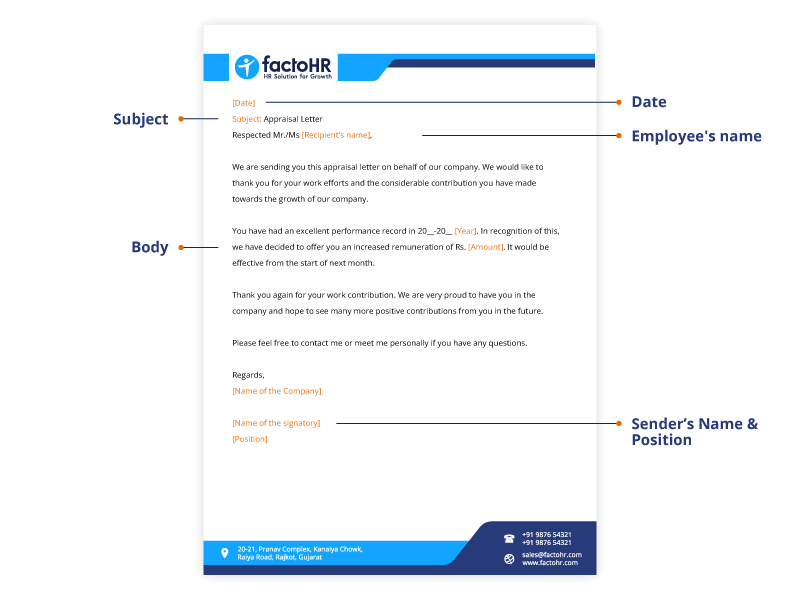Appraisal Letter | Meaning, Format, and Sample

Download Appraisal Letter Word Format For Free
Table of Contents
An appraisal letter is provided to the employee once their performance review is completed. If carried on rightly, it can become a great motivation for employees, eventually leading to the organization’s success. Because when employers take the time to carefully craft an appraisal letter, it serves as a valuable tool for motivating employees, guiding their professional development, and ensuring alignment with organizational objectives. By providing a detailed evaluation and constructive feedback, the appraisal letter enables employees to understand their strengths, recognize areas for improvement, and actively contribute to their personal growth.
Moreover, it offers employers an opportunity to show appreciation for the employee’s hard work and dedication, while setting the stage for productive discussions on career aspirations and goal-setting. However, if you are new to drafting appraisal letters, then you are at the right place. Here we will discuss everything about appraisal letters and provide you with a free appraisal letter format to download.

What is an Appraisal Letter?
Appraisal letter is a document that states an employee’s significant contributions, percentage of increment, and revised salary break up. It is given to the employees after the organization’s predefined performance appraisal process. It is written by the HR professionals specifically to praise the employees for their performance during the appraisal cycle. The letter signifies that the employer recognizes and encourages the employees’ efforts and motivates them for even better performance. The letter also describes the employee’s strengths, weaknesses, and areas of improvement.
The Purpose of an Appraisal Letter
An appraisal letter serves multiple purposes within an organization. Let’s explore some of its key objectives:
Assess Performance
The primary purpose of an appraisal letter is to assess and evaluate an employee’s performance objectively. It provides employers with a structured framework to analyze performance indicators, job responsibilities, and targets achieved.
Recognize Achievements
An appraisal letter offers an excellent opportunity to recognize and appreciate an employee’s accomplishments. By highlighting their successes, employers can boost morale, motivation, and job satisfaction, ultimately leading to increased productivity.
Identify Areas for Improvement
Constructive feedback is crucial for personal and professional development. An appraisal letter allows employers to identify areas where an employee can improve their skills, overcome weaknesses, and perform better. By providing specific examples and guidance, employers facilitate growth and self-improvement.
Set Goals
Clear goal-setting is essential for individual and organizational success. An appraisal letter provides a platform to collaboratively set goals that align with the employee’s aspirations and the organization’s objectives. By outlining expectations and timelines, employers ensure clarity and focus.
Facilitate Career Development
An appraisal letter serves as a career path for an employee’s career development. By discussing career aspirations, identifying growth opportunities, and suggesting professional development activities, employers demonstrate their commitment to their employees’ success and growth.
Things to Include in an Appraisal Letter
To ensure an inclusive and comprehensive appraisal letter, it is essential to include the following content:
Employee’s Old Salary
Begin the appraisal letter by mentioning the employee’s current salary. This provides context and serves as a reference point for the subsequent salary discussion.
Amount of Increment
Clearly state the amount of increment or raise the employee will receive. This information showcases the organization’s recognition of the employee’s contributions and highlights their value to the company.
Employee’s New Salary
Specify the employee’s new salary after the increment. Clearly outline the revised compensation package, including any additional benefits or bonuses. This ensures transparency and helps the employee understand the financial implications of the appraisal.
Effective Date from Which Salary Change will Take Place
Clearly communicate the effective date from which the salary change will take effect. This eliminates any confusion and allows the employee to plan accordingly. It is important to provide a specific date to ensure a smooth transition.
Employee’s Strengths or Weaknesses
As part of the performance evaluation, address the employee’s strengths and weaknesses. Identify and highlight their key strengths, showcasing the areas where they have excelled and made significant contributions to the organization. Additionally, discuss areas where the employee can improve and provide guidance on how they can enhance their skills.
Appreciation for the Work They Have Done
Express sincere appreciation for the employee’s hard work, dedication, and accomplishments. Acknowledge their valuable contributions to the team and the organization as a whole. Emphasize specific projects, initiatives, or achievements that have had a positive impact. This recognition motivates the employee and reinforces their commitment to excellence.

How to Write an Appraisal Letter?
To ensure an appraisal letter serves its purpose effectively, it is crucial to follow a structured approach. Consider the following elements while crafting an appraisal letter:
1. Appraisal Letter Heading
The heading of an appraisal letter should clearly indicate the purpose and context of the document. It typically includes the employee’s name, designation, and the appraisal period. For example, “Annual Performance Appraisal Letter: John Smith, Senior Marketing Manager (April 2022 – March 2023).”
2. Introduction and Context
Begin the appraisal letter with a brief introduction to set the tone and purpose of the communication. Mention the employee’s position, department, and the duration of their employment. This sets the context and prepares the employee for the content that follows.
3. Performance Evaluation
In this section, evaluate the employee’s performance objectively. Consider key performance indicators, job responsibilities, and targets achieved. Highlight specific accomplishments and provide examples to substantiate your evaluation. By providing specific feedback, you enable the employee to understand their strengths and areas of improvement.
4. Areas for Improvement
Constructively address areas where the employee can improve their skills or performance. Clearly articulate the specific areas for improvement, providing examples and suggestions on how to overcome challenges. Use positive language and offer support, emphasizing that these areas present growth opportunities for the employee.
5. Goal Setting
Collaboratively set clear, measurable, and realistic goals that align with the employee’s career aspirations and the organization’s objectives. Clearly outline the expectations and timelines for achieving these goals. By involving the employee in the goal-setting process, you foster a sense of ownership and commitment.
6. Development Plan
Discuss potential training programs, workshops, or mentoring opportunities that can help the employee enhance their skills and reach their goals. Encourage continuous learning and professional growth by providing resources and guidance. A comprehensive development plan showcases the organization’s investment in the employee’s success.
7. Feedback and Discussion
Allocate dedicated time to discuss the appraisal letter with the employee. Encourage them to share their thoughts, concerns, and aspirations. Create an open dialogue that fosters trust, transparency, and mutual understanding. Actively listen to the employee’s perspective and address any questions or concerns they may have.
8. Conclusion and Appreciation
Conclude the appraisal letter by summarizing the key points discussed. Express appreciation for the employee’s contributions, reiterating their value to the organization. Offer support and encouragement for their professional growth journey. A positive and appreciative tone enhances the impact of the appraisal letter.
Appraisal Letter Format

Conclusion
In conclusion, an appraisal letter is a powerful communication tool that empowers organizations to evaluate performance, recognize achievements, and foster professional growth. By following best practices and maintaining open dialogue, employers can create a positive work environment that promotes accountability, motivation, and success. Utilize the insights provided in this article to unlock the true potential of appraisal letters and harness their benefits for both employees and organizations. You can implement the use of HR software to ease your problems regarding creating and presenting employees with HR letters.

Download Our Resource
FAQs
1. What is the Ideal Length of an Appraisal Letter?
The ideal length of an appraisal letter typically ranges from one to three pages. It is important to strike a balance between providing sufficient feedback and avoiding unnecessary repetition or excessive detail. The letter should be concise, specific, and relevant, focusing on conveying the key points effectively. By maintaining a concise yet comprehensive approach, the appraisal letter can deliver an impactful message that promotes growth and motivation.
2. Can an Appraisal Letter Impact an Employee’s Career Progression?
Yes, an appraisal letter can significantly influence an employee’s career progression. It serves as a documented record of their performance, achievements, and areas for improvement, which can be taken into account during promotion or succession planning decisions. A well-crafted appraisal letter that recognizes achievements and provides actionable feedback can contribute positively to an employee’s professional growth.
3. How Should an Employer Handle Sensitive Issues in an Appraisal Letter?
Sensitive issues in an appraisal letter should be handled with tact, empathy, and professionalism. When addressing sensitive matters, it is crucial for the employer to maintain a balanced approach that focuses on constructive feedback and actionable suggestions for improvement. It is important to choose words carefully, ensuring that the feedback is clear, specific, and respectful. Employers should emphasize the employee’s strengths while addressing areas of improvement in a supportive manner. By fostering an open and non-judgmental environment, employers can create a safe space for dialogue and ensure that sensitive issues are addressed with care and consideration for the employee’s well-being and growth.
4. Is it Necessary to Include Numerical Ratings in an Appraisal Letter?
Including numerical ratings in an appraisal letter is not mandatory. The decision to use numerical ratings depends on the organization’s policies and practices. While numerical ratings can provide a quantifiable measure of performance, they should be fair, transparent, and based on objective evaluation criteria. However, it is important to note that the focus of the appraisal letter should be on providing meaningful feedback and guidance for improvement rather than solely relying on numerical ratings. The letter should aim to promote a holistic assessment of the employee’s performance, highlighting strengths, areas for improvement, and development opportunities.
5. Can an Employee Dispute the Contents of an Appraisal Letter?
Yes, employees have the right to dispute the contents of an appraisal letter. If an employee disagrees with the evaluation or has concerns about the information presented in the letter, they should have the opportunity to provide their feedback or express their concerns. Employers should foster a culture of open communication and provide a mechanism for dialogue and resolution. By engaging in constructive discussions, both parties can clarify any misunderstandings, address discrepancies, and work towards a mutual understanding. It is important for employers to listen attentively to the employee’s perspective, consider their input, and take appropriate steps to resolve any disputes in a fair and objective manner.
6. How Often Should Appraisal Letters be Conducted?
The frequency of appraisal letters depends on the organization’s policies and practices. Typically, they are conducted annually or semi-annually. However, regular feedback and performance discussions should occur throughout the year to ensure continuous improvement. The appraisal letter serves as a formal documentation and summary of these ongoing conversations.

Modernize your HR tasks with factoHR today
Experience the digitalization of everyday business activities with factoHR's modern and compatible solutions for every need.

© 2024 Copyright factoHR

